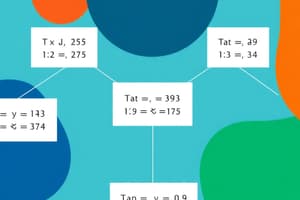Podcast
Questions and Answers
What is a proposition?
What is a proposition?
A proposition is a sentence that is either true or false, but not both simultaneously.
The sentence 'The integer x divides 2' is a proposition.
The sentence 'The integer x divides 2' is a proposition.
False (B)
What is the truth value assigned to a true proposition?
What is the truth value assigned to a true proposition?
1 or T
What is the truth value assigned to a false proposition?
What is the truth value assigned to a false proposition?
What is a predicate?
What is a predicate?
What does the negation of P (¬P) represent?
What does the negation of P (¬P) represent?
Match the logical connectives with their definitions:
Match the logical connectives with their definitions:
When is a conjunction (P ∧ Q) true?
When is a conjunction (P ∧ Q) true?
When is a disjunction (P ∨ Q) false?
When is a disjunction (P ∨ Q) false?
Flashcards are hidden until you start studying
Study Notes
Proposition (statement), Truth Table
- Definition: A proposition is a sentence that can be definitively true or false, but not both.
- Notation: Propositions are represented using letters: P, Q, R, etc.
- Examples:
- "For all real numbers x, x² ≥ 0" (True proposition)
- "2 x 3 = 5" (False proposition)
- "The integer x divides 2" (Not a proposition, as it depends on the value of x)
- Truth Values:
- True propositions are assigned the value 1 (or T).
- False propositions are assigned the value 0 (or F).
Truth Table
- Definition: A truth table displays the truth values of a proposition for all possible combinations of truth values of its components.
- Example: Truth table for a proposition P:
| P |
|---|
| 1 |
| 0 |
Predicate
- Definition: A predicate is a logical formula that depends on one or more free variables. The truth value of a predicate is determined by assigning specific values to its variables.
Basic Logical Connectives
a) Negation
- Notation: "¬P" or "Not P"
- Definition: The negation of a proposition P is true if P is false, and false if P is true. It essentially reverses the truth value of P.
- Truth Table:
| P | ¬P |
|---|---|
| 1 | 0 |
| 0 | 1 |
- Examples:
- Given P: "2 × 3 = 6", its negation ¬P is "2 × 3 ≠ 6".
- Given Q: "√2 ∈ N" (√2 is a member of the set of natural numbers), its negation ¬Q is "√2 ∉ N" (√2 is not a member of the set of natural numbers).
b) Conjunction
- Notation: "P ∧ Q" or "P and Q"
- Definition: The conjunction of propositions P and Q is true only if both P and Q are true. Otherwise, it's false.
- Truth Table:
| P | Q | P ∧ Q |
|---|---|---|
| 1 | 1 | 1 |
| 1 | 0 | 0 |
| 0 | 1 | 0 |
| 0 | 0 | 0 |
- Examples:
- "π is not an integer and π > 2"
- "f(x) is decreasing and f(x) = e^x"
c) Disjunction
- Notation: "P ∨ Q" or "P or Q"
- Definition: The disjunction of propositions P and Q is false only if both P and Q are false. Otherwise, it's true.
- Truth Table:
| P | Q | P ∨ Q |
|---|---|---|
| 1 | 1 | 1 |
| 1 | 0 | 1 |
| 0 | 1 | 1 |
| 0 | 0 | 0 |
- Examples:
- "π ≥ 2 or e > 1"
- "π = 3 or e < 2"
Studying That Suits You
Use AI to generate personalized quizzes and flashcards to suit your learning preferences.




